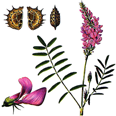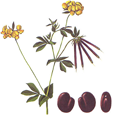Home » Leguminosae

FODDER PLANTS - LEGUMINOSAE
All the seeds listed below are available also with biological agriculture.
Alfalfa (Medicago sativa L.)

This is the most important fodder plant thank to its high productivity, good longevity and regrowth. Fodder yielded has an high proteinic value and improves the physical-chemicals characteristics of the ground.
Doses e ways of sowing:
We suggest to use 30-40 Kg/ha of seeds in a heavy ground. Instead use 20-25 Kg/ha for light grounds.
Available varieties: Valleverde, others.
White clover (Trifolium repens L.)

It is excellent for mowing and pasture. It supplies a excellent quality of fodder with leaflets and inflorescences and a low content of fibres but an high proteinic content. It's a perennial plant because of its capacity of propagation with creeping gait.
Doses e ways of sowing:
Broad casting, we suggest 6-7 kg/ha of seeds for a pure growing. In association with ladino can be used in coupled growings and multple growings.
Different available varieties.
Red clover (Trifolium pratense L.)

Biennal fodder with a good energetic and proteinic value. Good cold and humid proof. Improves the physical-chemicals characteristics of the ground.
Doses e ways of sowing:
The pure growing can be done on bare ground with mechanical sowing in rows spaced out 2,76-3,95 inches. Advised dose of seed is 25-30 kg/ha.
Different available varieties.
Egyptian clover (Trifolium alexandrinum L.)

Excellent fodder plant with high nutritive value and fast development for a quick regrowth. It can be used with brief duration as alternated growing until the end of the cycle (reaping included). It can be used as fodder and seed.
Doses e ways of sowing:
Advised mechanical sowing in rows spaced out 2,76-3,95 inches with 25-30 kg/ha for single growings.
Available varieties: Luis, Torre, others.
Crimson clover (Trifolium incarnatum L.)

This is tipical plant for herbarium because opf its fast and plentiful development. It can be used as green manure. Among annual Trifolium, this is the one that has the best cold proof. It can be grown even at 1000 meters o.s.l.
Doses e ways of sowing:
In a single growing with mechanical sowing we suggest 25-30 kg/ha. Doses for broad casting have to be increased up to 40-45 kg/ha.
Different available varieties.
Subterranean clover (Trifolium subterraneum L.)

It adapts itself to intense and continuous pasture. Even if annual plant, thank to its auto-resowing capacities, is a species for perennial growing. It adapts itself to warm-dry surroundings of the Mediterranean Basin.
Doses e ways of sowing:
There are not particular requirements about tilling. It prefers light, sand-slime and poor grounds. Autumnal sowing with following doses: pure pasture, 25-30 Kg/ha of seeds.
Different available varieties.
Sea clover (Trifolium squarrosum L.)

Fodder plant with annual cycle that adapt itself very well to the areas of the centre but over all in the south of Italy. It's used as alternated growing.
Doses e ways of sowing:
Advised mechanical sowing in rows spaced out 2,76-3,95 inches with 30-35 kg/ha for single growings.
Different available varieties.
Alsike clover (Trifolium hybridum L.)

Very rustic fodder plant adapts itself very well to cold-humid climates. It grows both acid and alkaline grounds and even with peat ones. Si sviluppa sia in terreni alcalini che acidi, compresi quelli torbosi. Growing has a duration of 2-3 years. It's suggested a springs sowing. This fodder plant is adapt both pasture and cutting.
Doses e ways of sowing:
For single growing doses are 8-10 Kg/ha for mechanical sowing 12-15 Kg/ha for broad casting. It adapts better itself to coupled growings with Fleolo and to multiple growings with Trifolium repens L., Dactylis glomerata L., Festuca pratense, Festuca rubra.
Different available varieties.
Sweet vetch (Hedysarum coronarum L.)

It's spontaneous in almost every countries of the Mediterranean Basin. Italy is the country where is mainly grown, with a surface of 300.000 ha. This plant has a remarkable rusticity, has mainly used for single growings. It's not late cold proof. Good quality of fodder.
Doses e ways of sowing:
For a good growing is necessary take care of preparations. Ploughing of 11,84-15,79 inches has to be followed by a good crumbling and levelling of the ground to avoid noxious stagnations. Suggested doses are: mechanical sowing 25-30 Kg/ha and broad casting 40-45 Kg/ha.
Available varieties: Silvan, others.
Sainfoin (Onobrychis viciaefolia Scop.)

Very rustic fodder plant adatpts itself very well to calcareous, gravelly and sandy grounds. It bears high temperatures and drought. Very longeval plant (7-8 years) and is good for pasture thank to its prostrate gait.
Doses e ways of sowing:
Suggested doses for a pure sowing are 60-70 Kg/ha of bare seed or 160-170 Kg/ha of clad seed. For coupled growings can be associated with Dactylis glomerata L. or Festuca. In multiple growings with Erba medica, Festuca e Dactylis glomerata L.
Available varieties: commercial.
Bird's foot trefoil (Lotus corniculatus L.)

Lotus corniculatus provides an excellent fodder, overall the hay is very well-finished, aromatic and with high nutritious value. It's resistant to water excesses and lack and also to the saltiness.
Doses e ways of sowing:
In Italy, the pure growing is not much used. Doses are: 13-15 Kg/ha of seed. In a coupled growing can be associated to Fleolo o Festuca. In a multiple growing can be associated to Trifoglio pratense, Dactylis glomerata L., Festuca ovina, Phleum pratense L.
Different available varieties.
Large Russian vetch (Vicia villosa Roth.)

This is tipical plant for herbarium, with good cold proof. Its rusticity makes it adapt to acid grounds and alkaline ones. It has an excellent resistance to hot and dry climates. It has a crwaling gait which make it able to suffocate infesting plants.
Doses e ways of sowing:
It's not suggested the pure sowing, if not in particular occasions (green manure) where usually it's grown in association with a cereal as rye or oats. Doses advised for this kind of sowing are: 100-120 Kg/ha of seed where 45% is vicia and 55% is rye or oats.
Different available varieties.
Winter tares (Vicia sativa L.)

Tipical plant for herbarium is appetizing to livestock. It adapts itself to almost every kind of surroundings but overall those not too much humid and cold. It's mainly used as intercalate growing like autumnal-springs herbariumin association with gramineae.
Doses e ways of sowing:
It's a fodder plant inserted into mixes. It's suggested mechanical sowing. Classic mix is oats-vicia-pea for a green fodder. Ratio seed among species can be indicated as 30-30-40 with doses 140-160 Kg/ha.
Different available varieties.
Pigeon bean (Vicia faba minor Beck.)

Excellent plant for herbarium with high reproductive capacities. It's also an excellent leguminosae for seed with autumnal-springs development. It's good as plant for green manure. It's an improving plant and inside a succession is a plant for renewal.
Doses e ways of sowing:
In Central-South regions is tipical am autumnal-springs sowing (September-October). It can be used as pure as mix. Doses for a pure growing are 150-200 Kg/ha while for a mix with oats or barley are 100-120 Kg/ha of vicia and 80-90 Kg/ha of oats or barley.
Different available varieties.




